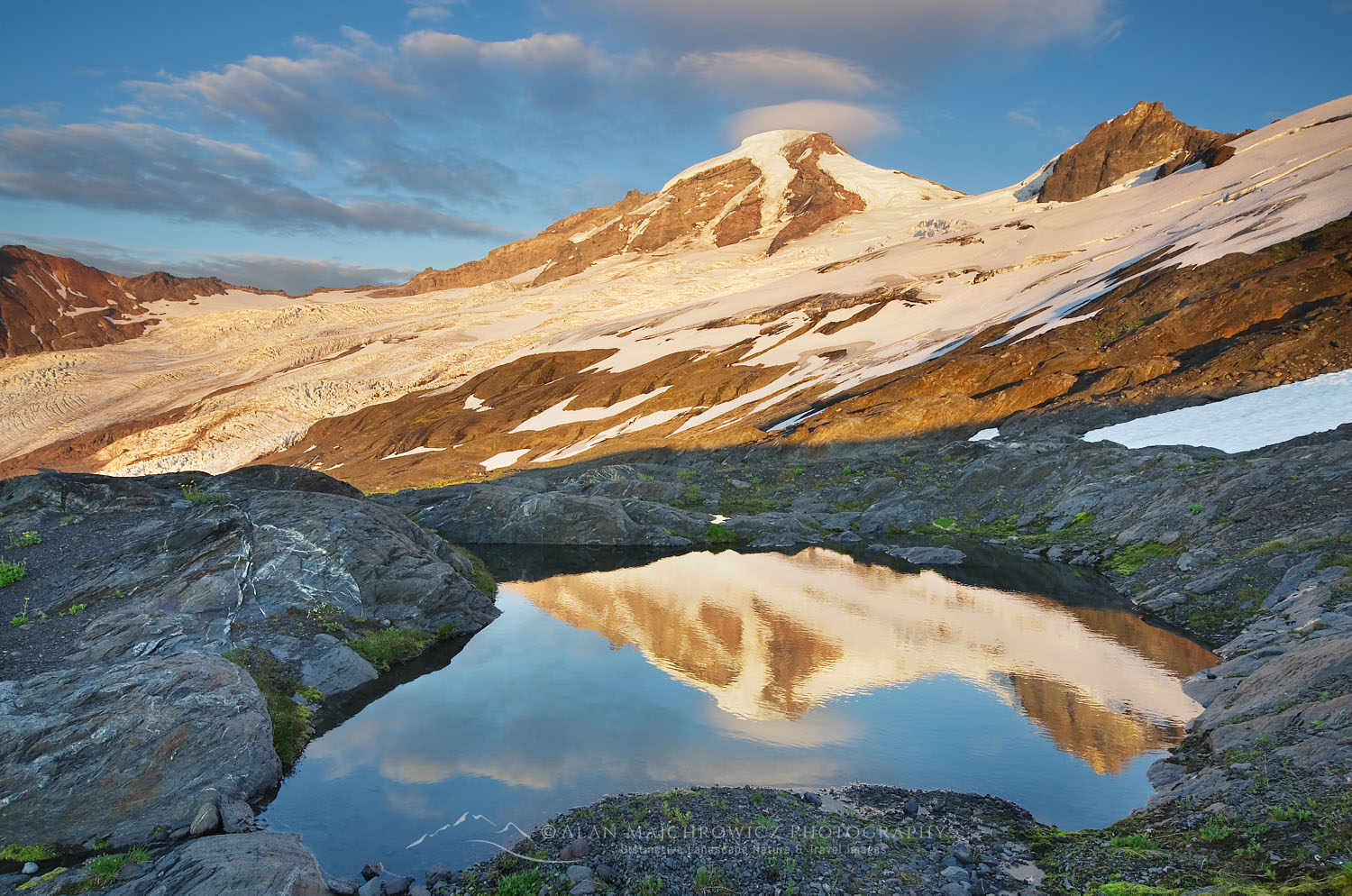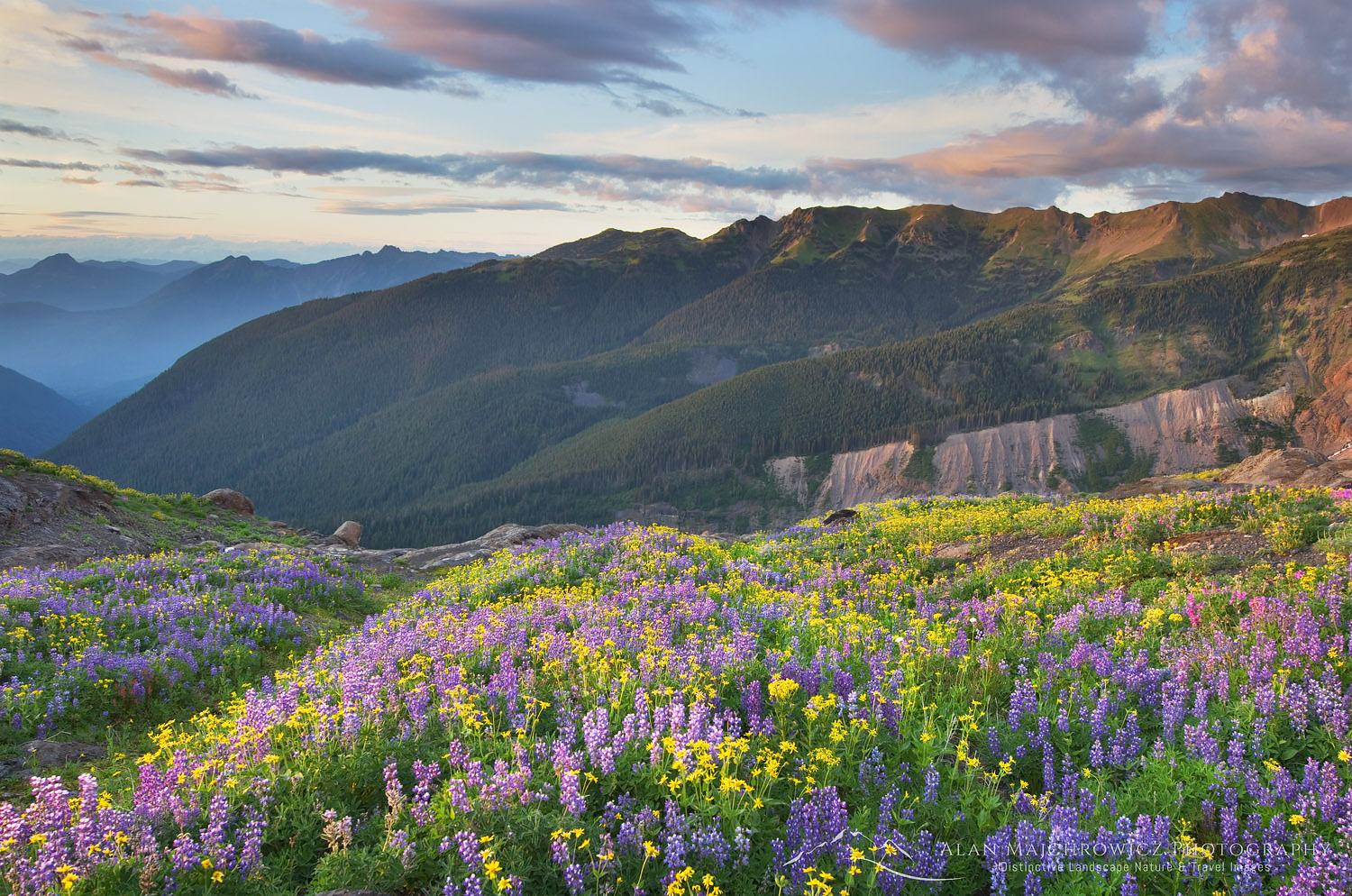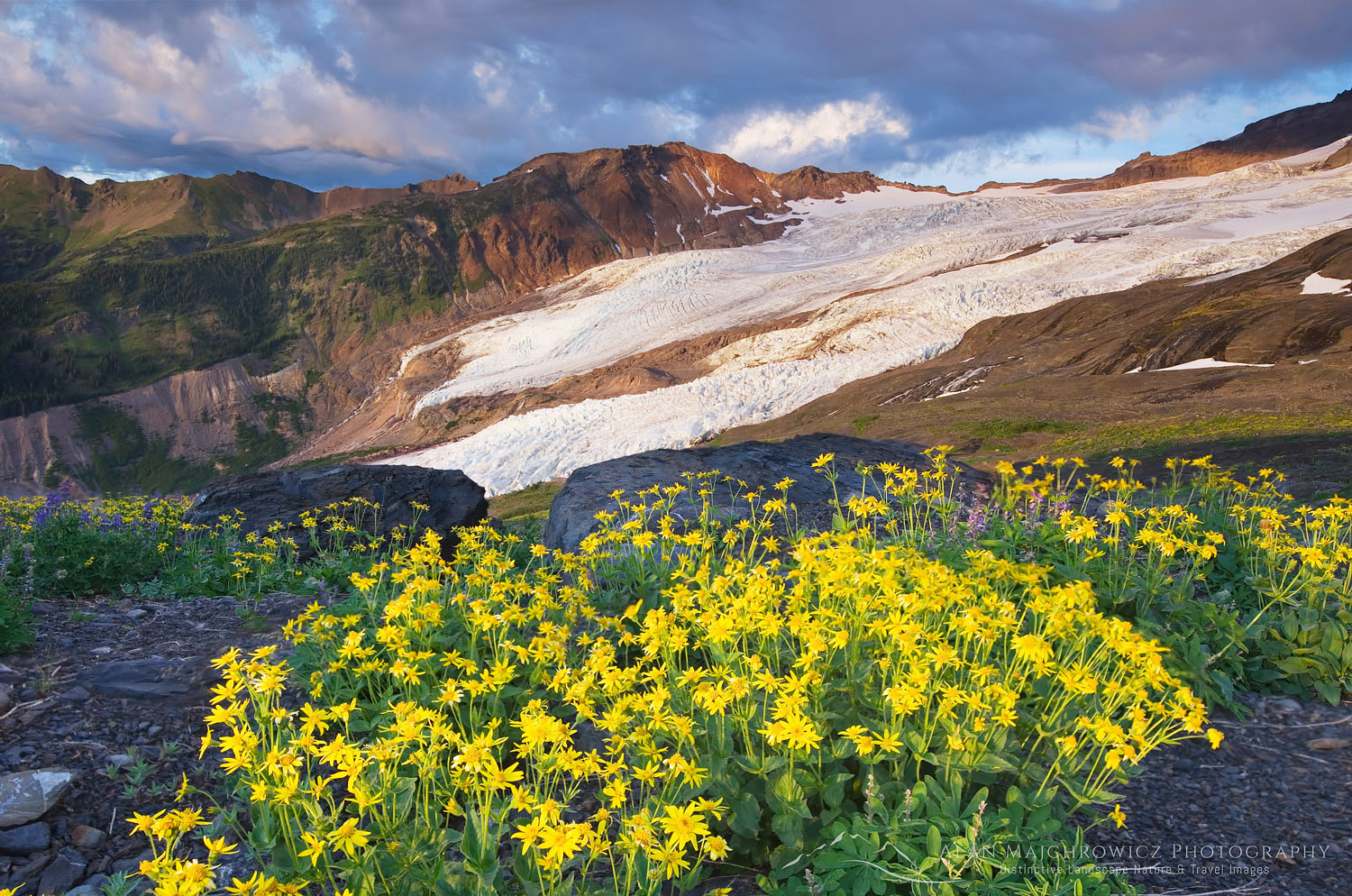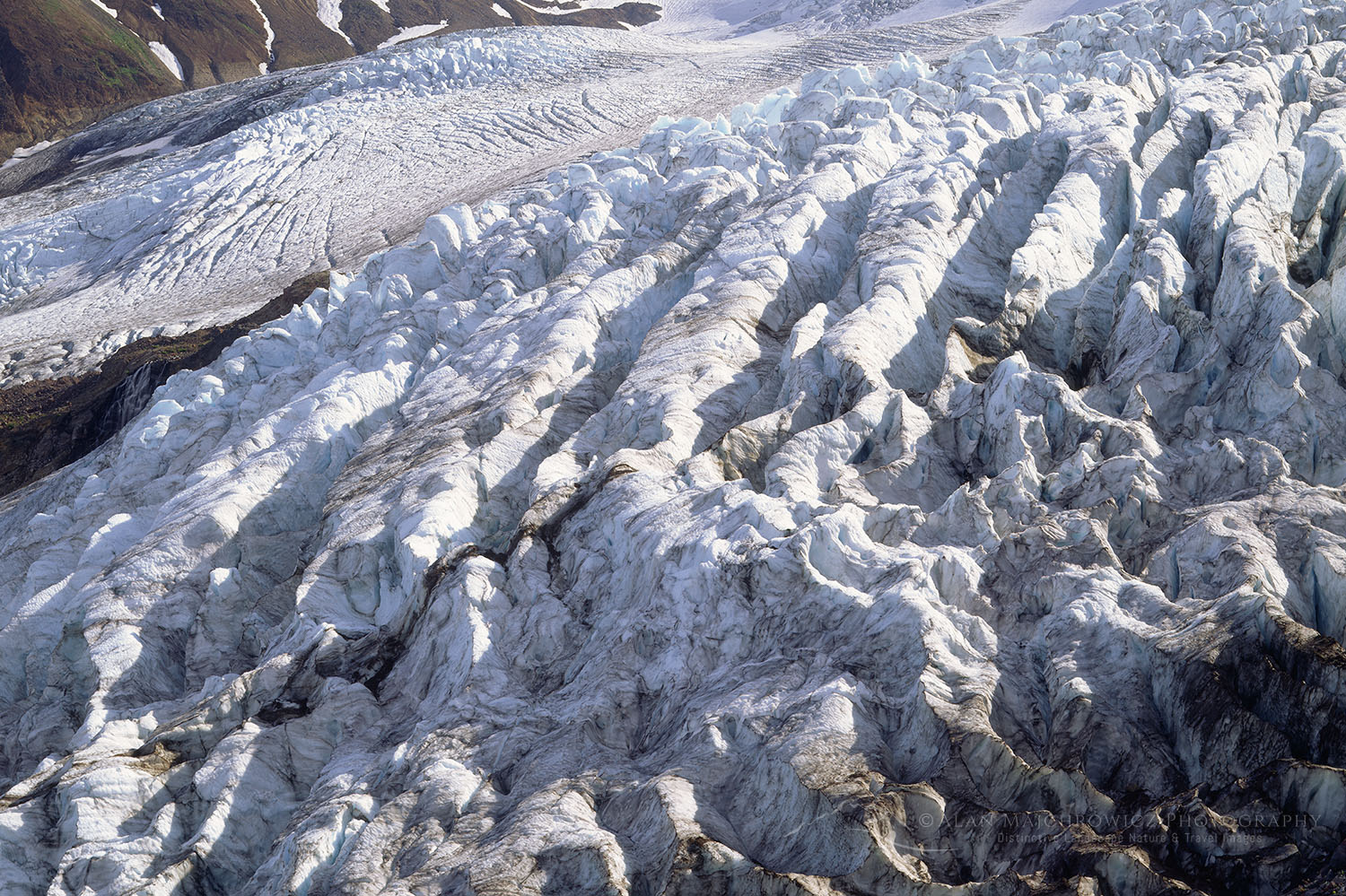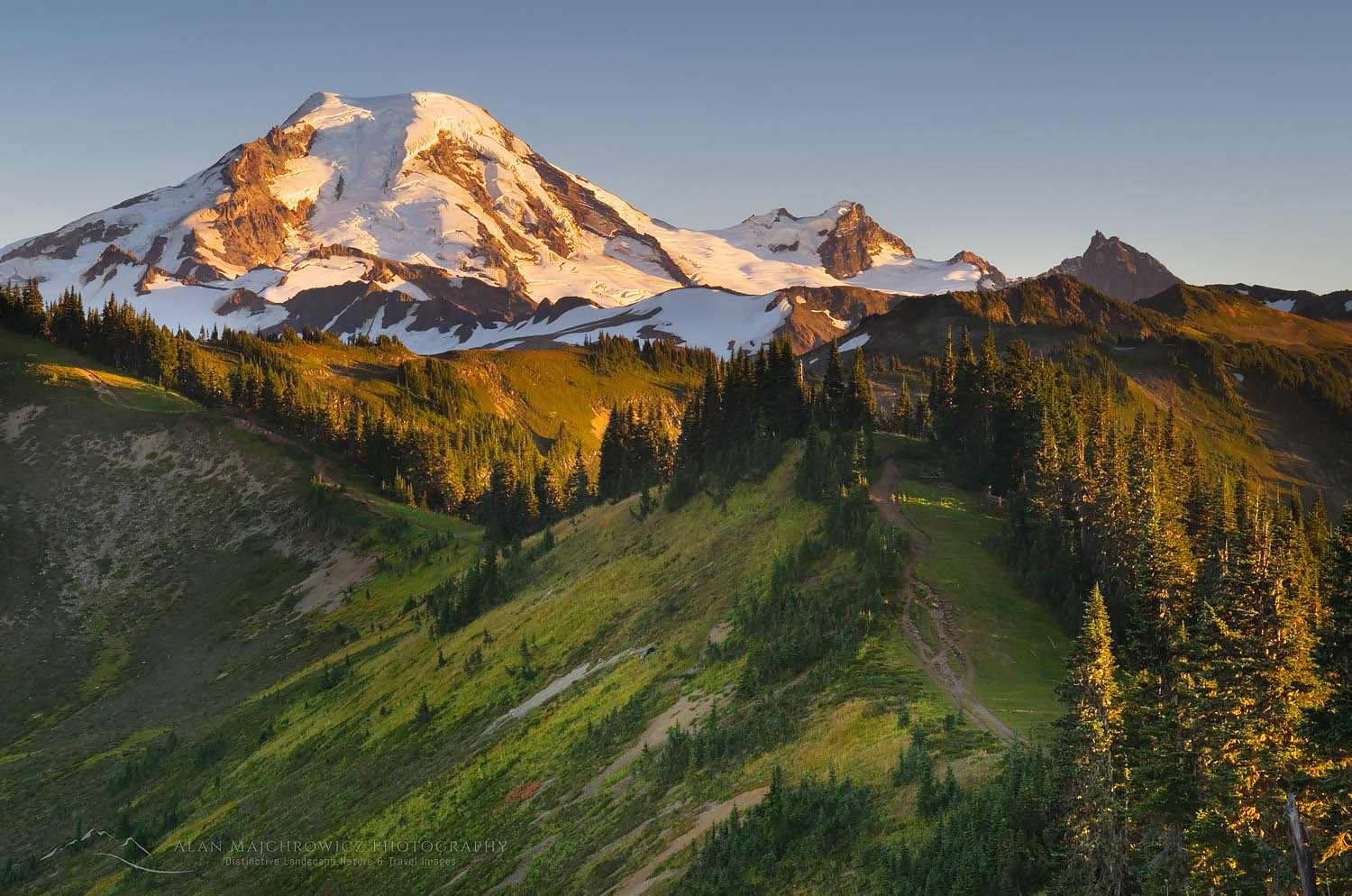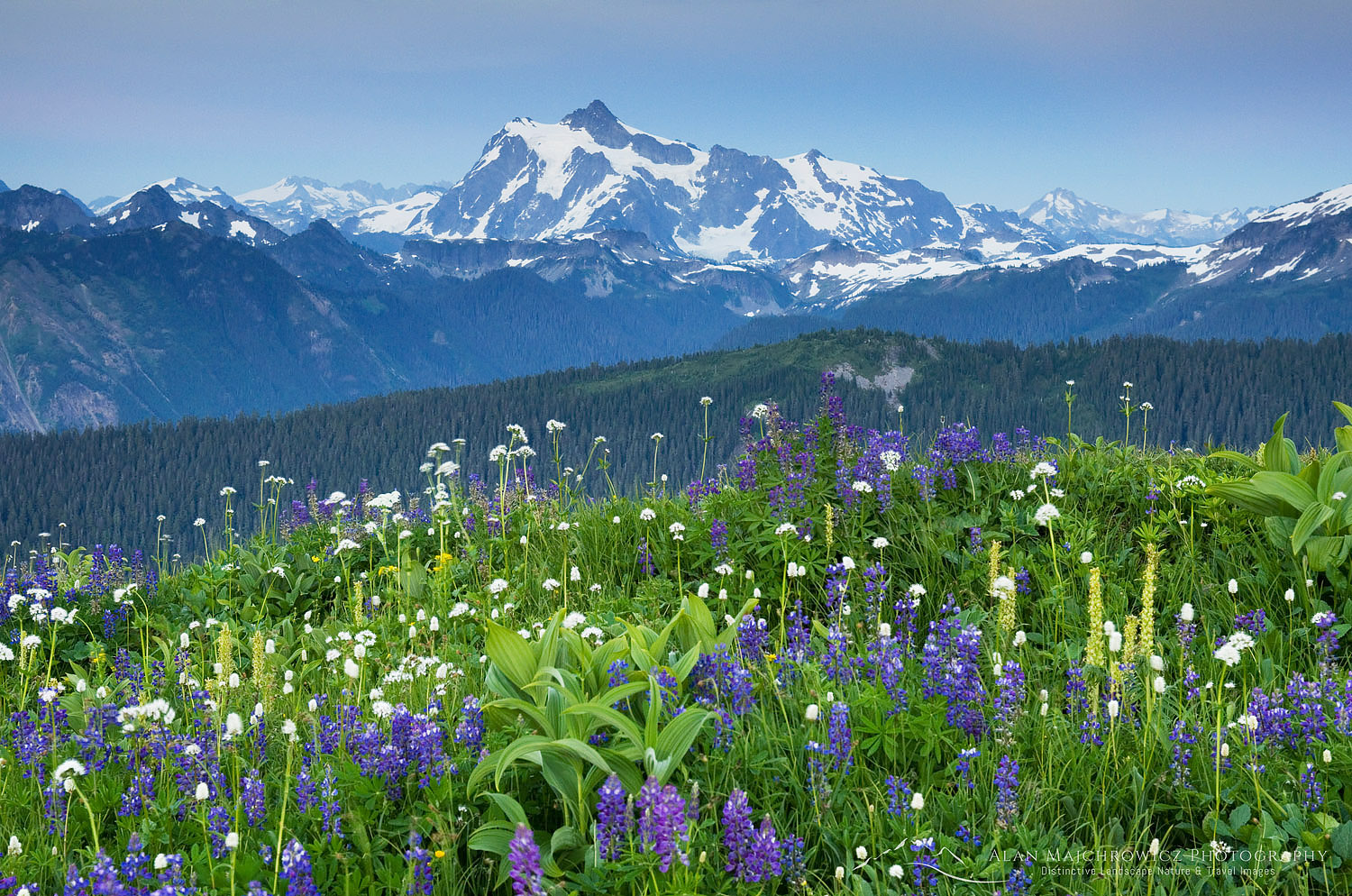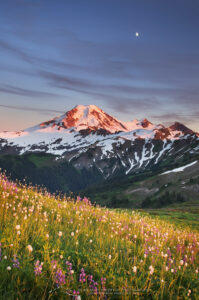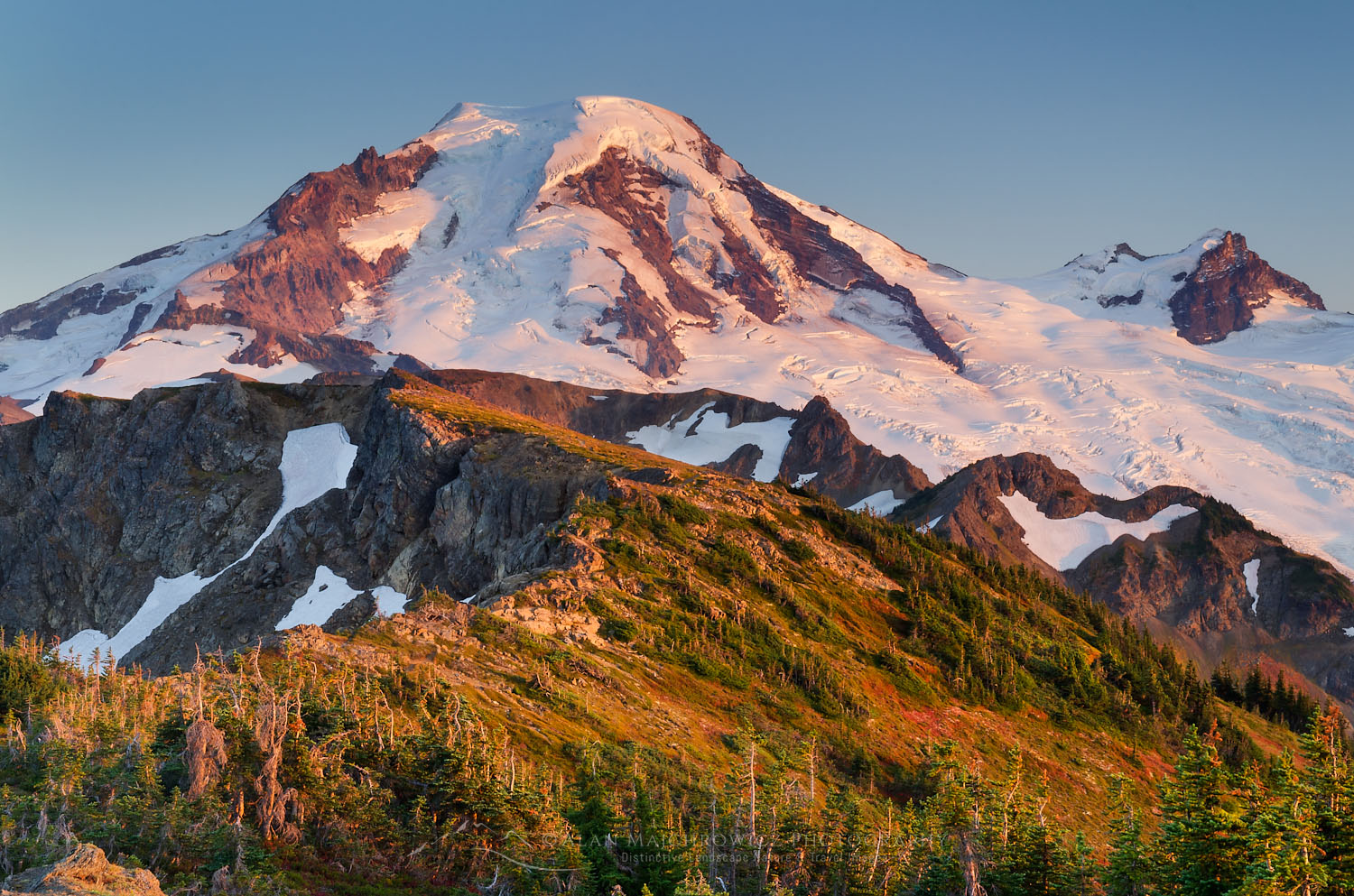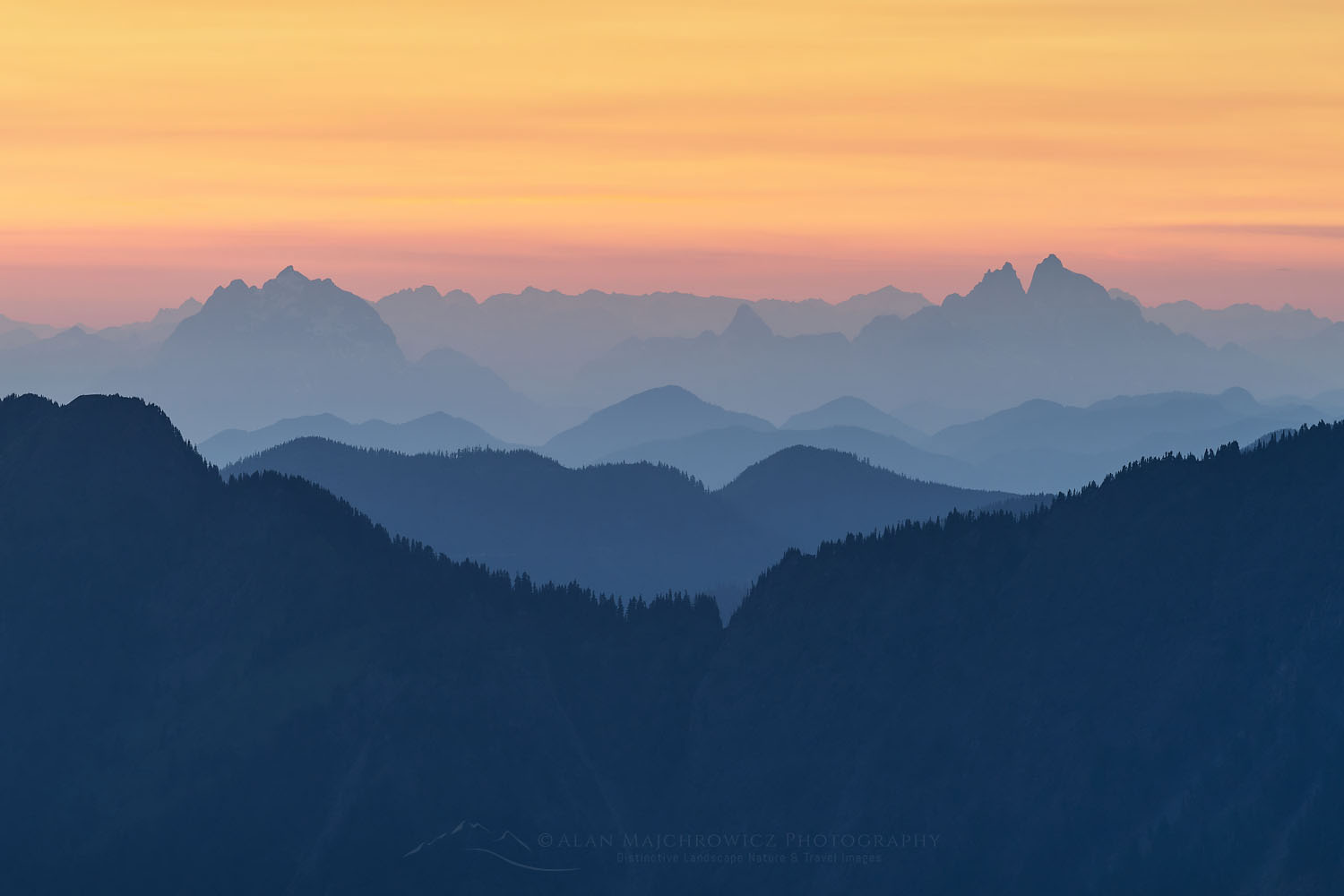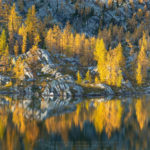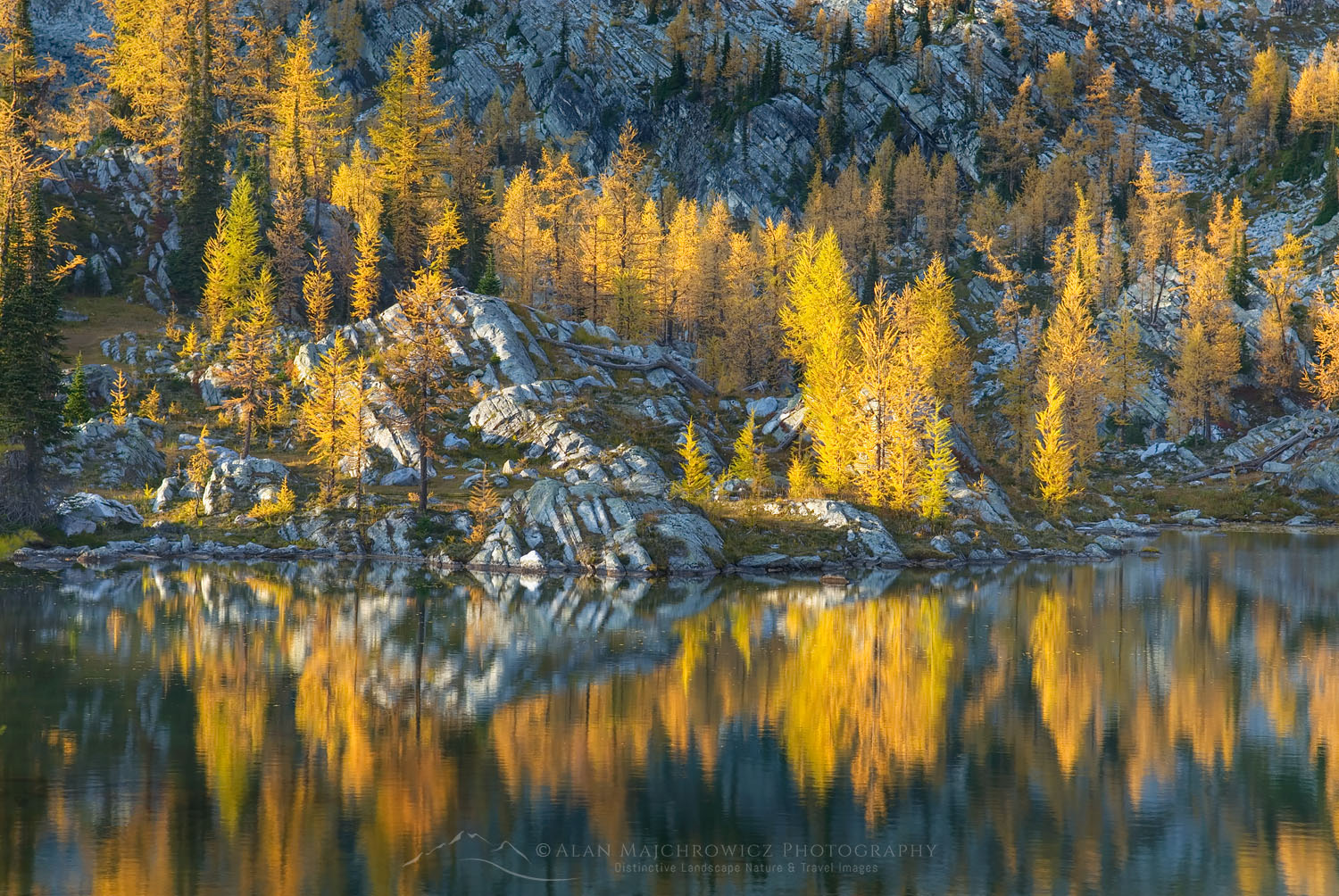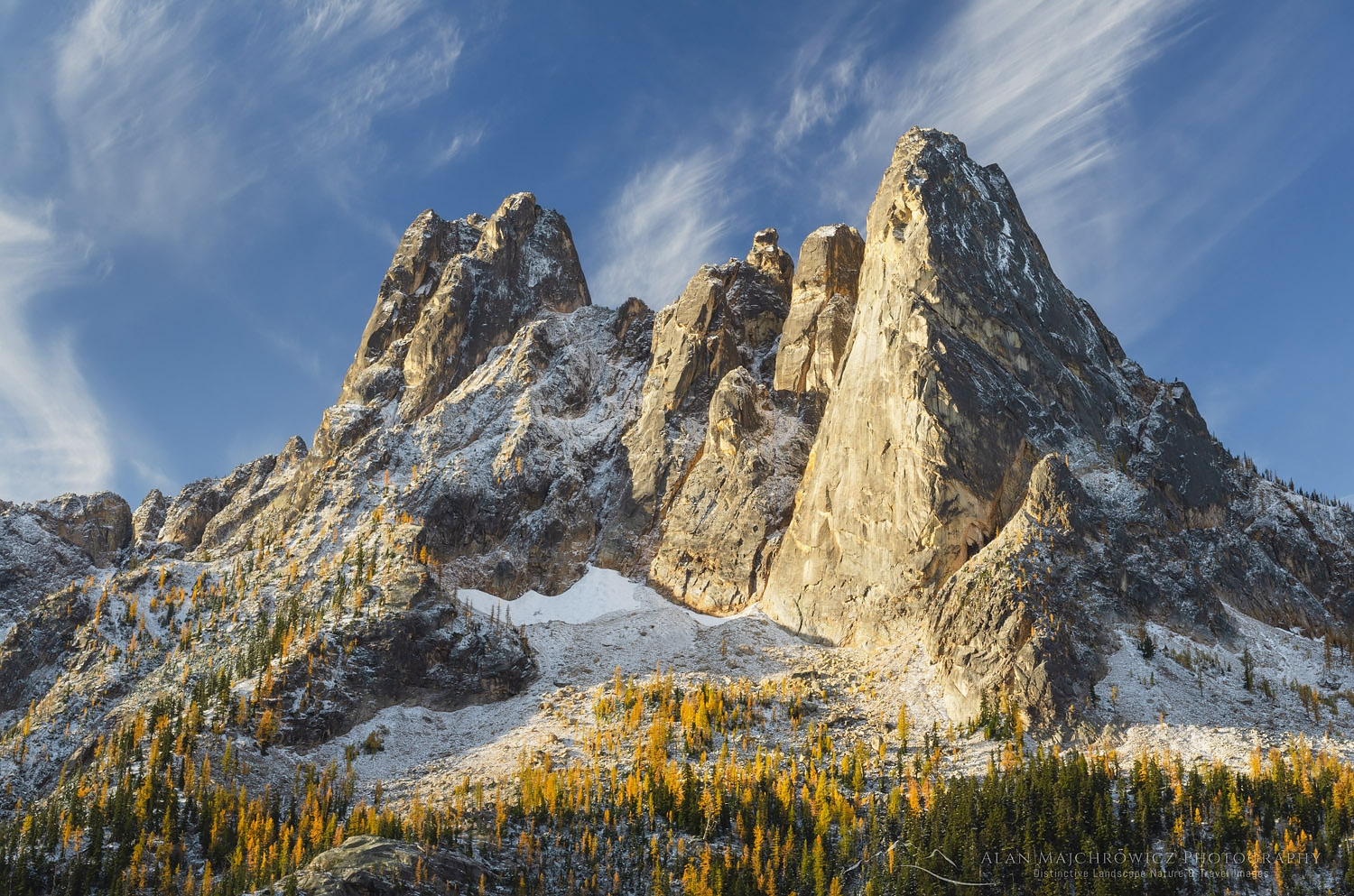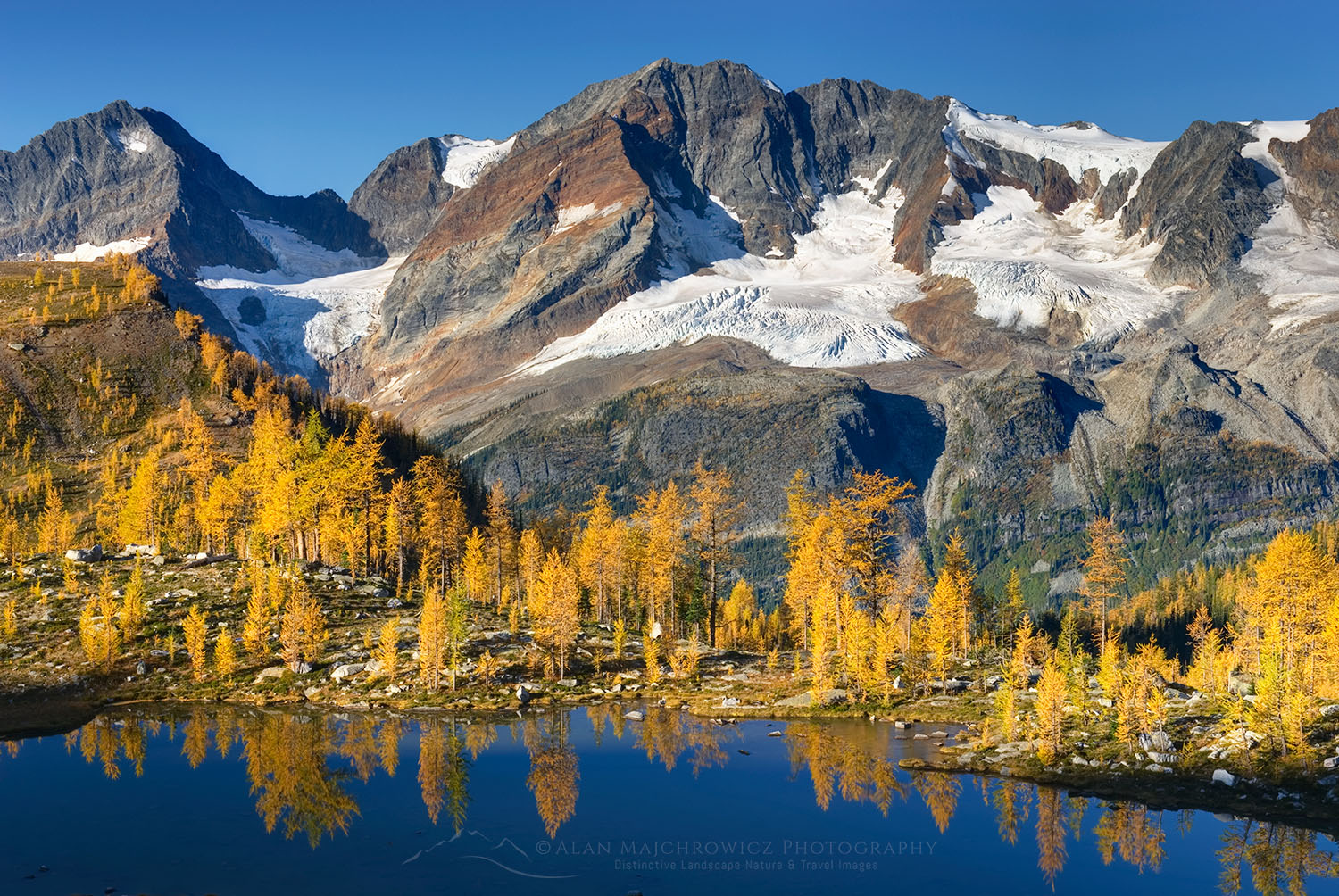Lake Ann Ptarmigan Ridge Mount Baker Wilderness
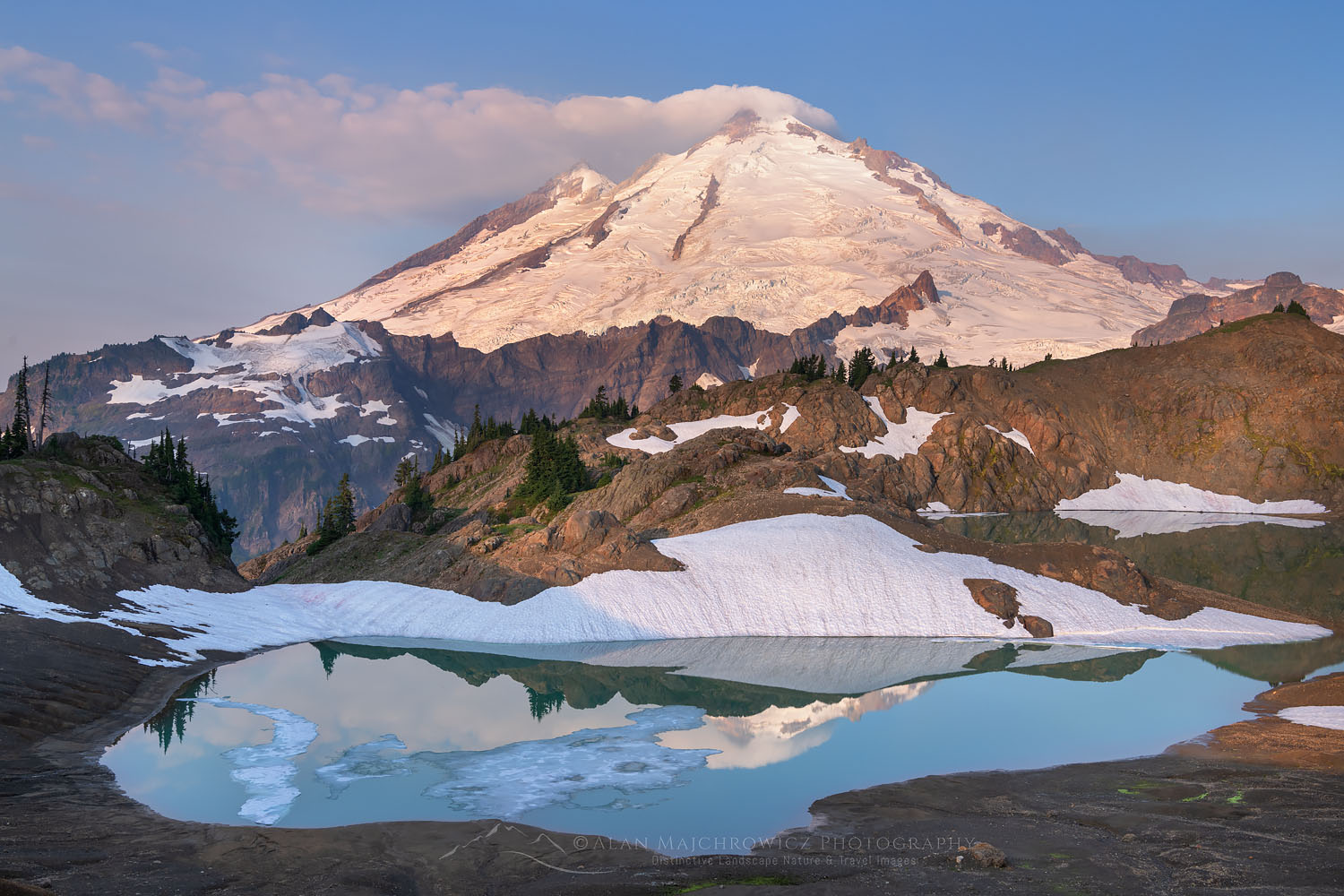 Mount Baker and Goat Lake #73706 Purchase
Mount Baker and Goat Lake #73706 Purchase
This post is the next installment of Mount Baker Wilderness Destinations. This time, we will discuss two hikes that start in Heather Meadows, Lake Ann, and Ptarmigan Ridge. These hikes are unusual in the North Cascades since the trailhead is higher up in the sub-alpine. Most trails in the North Cascades involve considerable elevation gain to reach the alpine. Heather Meadows and parts of Mount Rainier National Park are a few areas where trails start high.
Another bonus is that both of these trails lead to close views of Mount Baker and Mount Shuksan. These mountains display two geological features that define the North Cascades, volcanism and complex metamorphic terrane. Even if you’re not a geologist there is plenty of material here to pique your interest in the subject.
Essential Tip: Both of these trails are among the most heavily used in the Northwest. Expect to see plenty of people, every day of the week. Get to the trailhead parking very early in the morning or you may not find a parking spot.
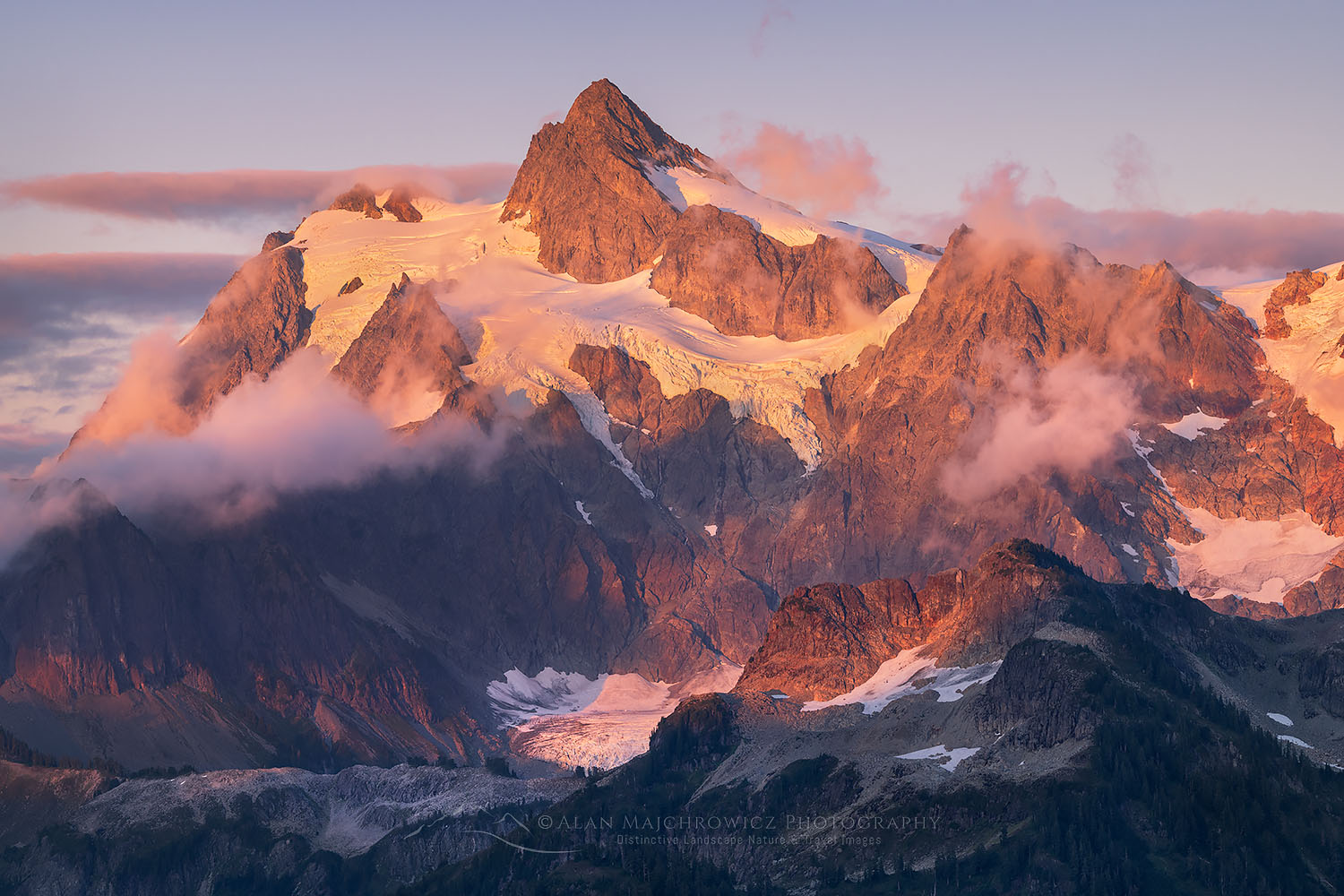 Mount Shuksan seen from Ptarmigan Ridge 73588 Purchase
Mount Shuksan seen from Ptarmigan Ridge 73588 Purchase
Ptarmigan Ridge Trail
Length: 9 miles roundtrip to glacier overlook at the Portals
Elevation Gain: 1800′
Getting there: From Bellingham drive Mount Baker Highway, SR 542, about 58 miles to its end at Artist Point. The last section beyond the ski area usually is not plowed until late June, and some years not until August. If the road is still under snow come back a few weeks later since the trail itself will still be buried in deep snow.
Ptarmigan Ridge is hands down one of the most scenic trails in the Northwest. You would be hard-pressed to find another trail in the North Cascades which travels through the alpine as long as this one. If you hike only the first mile or go all the way to the glaciers of Mount Baker, every step brings fantastic views. That said, this trail is suitable for day-hikes and overnight-night backpacking. It is also one of the approaches for climbing Mount Baker, although it’s probably the longest one. And even in late summer, you’ll see people packing skis and searching for more turns.
Essential Tip: Due to its elevation and proximity to Mount Baker, the weather maker, this trail is usually deep under snow until mid-August. A few sections never melt out. Crampons or micro-spikes and an ice axe will come in handy for early-season hikers.
Essential Tip: Do not confuse this trail with the Ptarmigan Traverse. The Ptarmigan Traverse is a climbers-only route which starts south of Highway 20, at Cascades Pass in North Cascades National Park.
 Hikers on Ptarmigan Ridge Trail, Mt. Baker (L), Coleman Pinnacle (R) #73720 Purchase
Hikers on Ptarmigan Ridge Trail, Mt. Baker (L), Coleman Pinnacle (R) #73720 Purchase
Hiking Ptarmigan Ridge
For the first mile, the trail is mostly level and traverses open slopes below Table Mountain. Soon after is a junction with the Chain Lakes Trail, another outstanding hike. Then the trail drops down a few hundred feet and crosses numerous streams before beginning to climb through a vast slope of volcanic rock. This last section, before gaining the ridge again, is usually under snow until late in the season. Just pick the easiest way to the ridge or follow tracks from other hikers.
Gaining the ridge the trail then begins a grand tour winding along ridges in alpine heaven. At around 3.8 miles the trail takes a sharp right turn and starts up a steep grassy slope below Coleman Pinnacle. This is also where you can leave the trail to visit beautiful Goat Lakes, just to the south.
 Mount Baker, The Portals are seen as black butte on right #73714 Purchase
Mount Baker, The Portals are seen as black butte on right #73714 Purchase
The last section crosses a sort of ridge plateau made of volcanic boulders and ash. Some of the best camping spots on the trail are here. Finally, the trail ends just below the Portals, a crumbling volcanic hill. Rough paths climb to the top where there are close-up views of Mount Baker and glaciers in nearly every direction.
This is about as far as a hiker can safely go, and it’s a great spot to have lunch before heading back.
Essential Tip: Do not attempt to travel on any of the nearby glaciers unless you have the proper equipment and training.
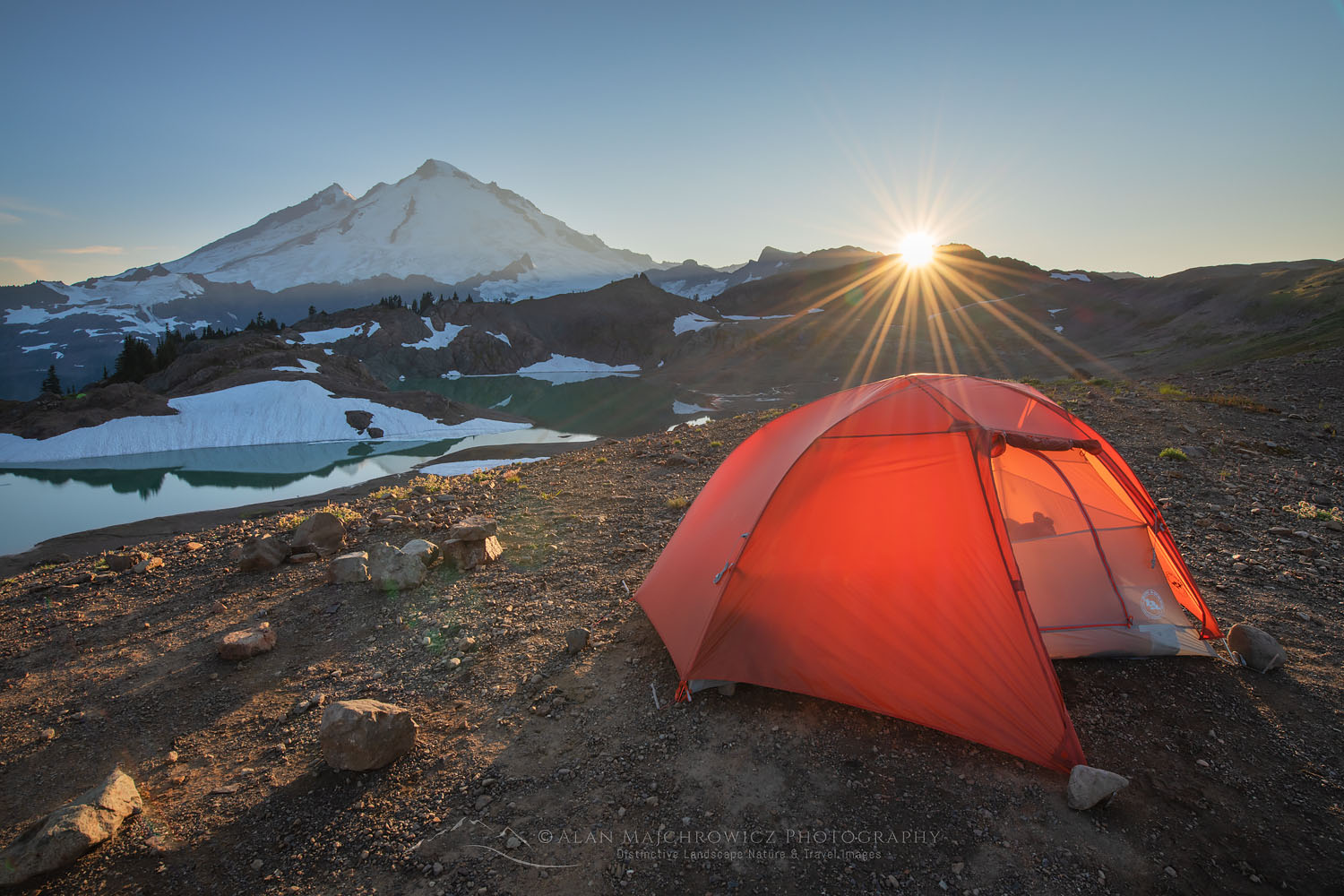 Campsite on Ptarmigan Ridge Mount Baker Wilderness #73634 Purchase
Campsite on Ptarmigan Ridge Mount Baker Wilderness #73634 Purchase
Camping on Ptarmigan Ridge
I can’t imagine anyone hiking this trail without thinking of how great it would be to camp somewhere along the ridge. There are only a few sections on the route which are flat enough to spread out a tent. And some of those are close to heavy traffic areas. The best spots are around Goat Lake, about 4 miles in, and at the trail end on the 5790′ volcanic plateau.
For Goat Lake find a faint path heading down and south where the trail veers to the right below Coleman Pinnacle. The first short section is very steep on loose rock, and it’s essential to make sure you’re on the correct path. Once it levels out there are good sites on the way to the lake. Although the lake isn’t far it’s a longer walk than it looks. Also, keep in mind that this is one of those areas that retain snow long into the summer. Some years the lake doesn’t even completely melt out.
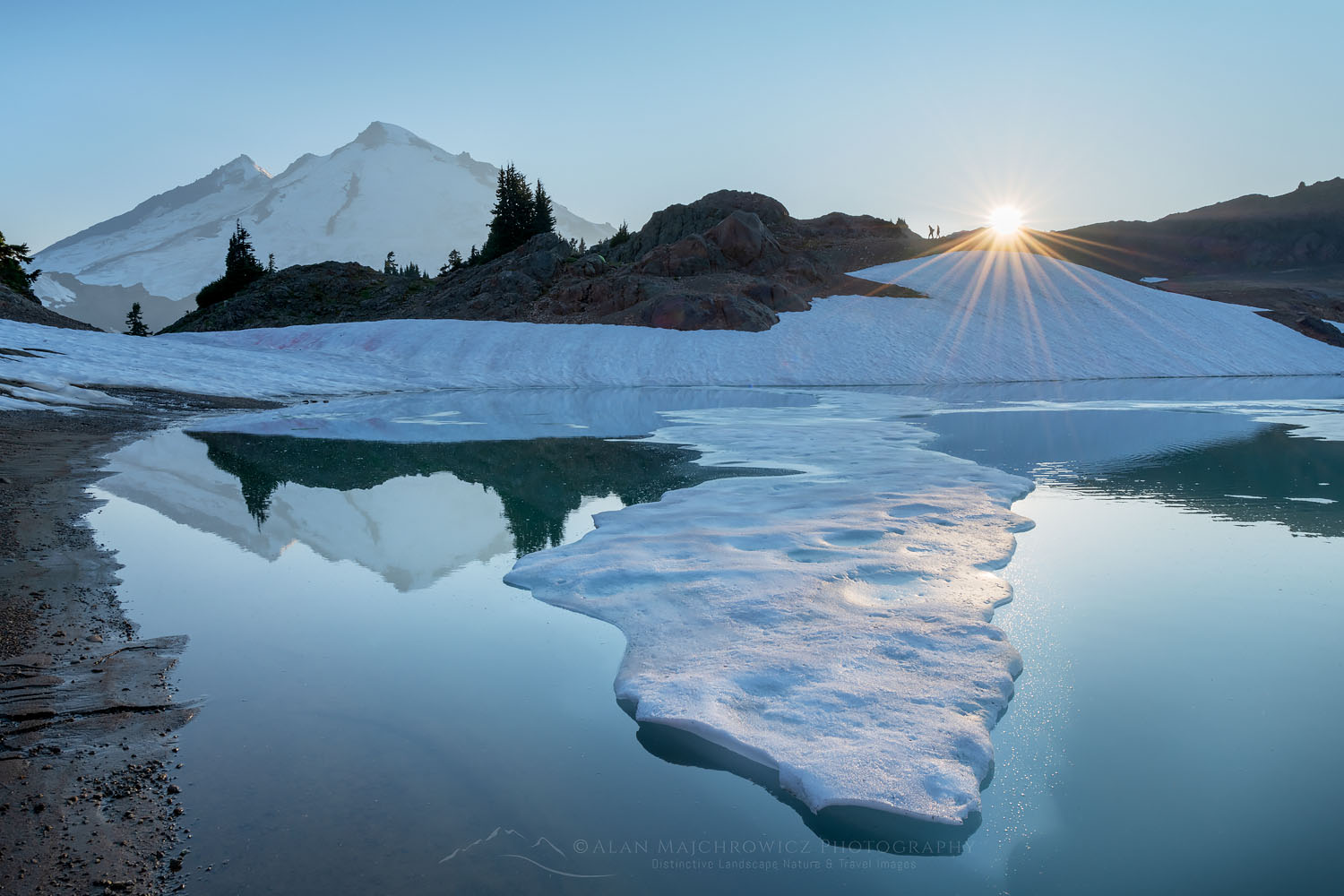 Mount Baker and Goat Lake #73622 Purchase
Mount Baker and Goat Lake #73622 Purchase
Photography on Ptarmigan Ridge
There are excellent photo opportunities along the entire length of the Ptarmigan Ridge Trail. Indeed, only a few steps from the parking area at Artist Point are some of the most iconic views of Mount Baker and Mount Shuksan.
For wildflowers enthusiasts, there are a few areas worth checking out. The first basin beyond the Chain Lakes trail junction has many streams with mossy borders and yellow and purple monkeyflowers. Another good location is the northeast side of Goat Lake. It’s worth mentioning that due to the heavy snowpack, most wildflowers in the area will be late bloomers.
My favorite area for photography is Goat Lake. Spending the night here rewards the photographer with a beautiful evening and morning light. This is also an outstanding location for night photography. Plus, there are plenty of elements around the lake which can you can use in compositions. These include lake reflections of Mount Baker, patterns of ice on the lake, and wildflowers.
I would suggest bringing along a full kit of lenses, from ultra-wide to medium telephoto. A longer focal length lens can isolate patterns of crevasses on glaciers. And if you’re lucky, a telephoto is useful to catch wisps of steam emanating from the crater below Sherman Peak on Baker.
 Lake Ann and Mount Shuksan #58150 Purchase
Lake Ann and Mount Shuksan #58150 Purchase
Lake Ann
Length: 8 miles roundtrip to Lake Ann / 10 miles roundtrip to Mount Ann
Elevation Gain: 1900′ roundtrip to Lake Ann / 2800′ roundtrip to Mount Ann
Getting there: From Bellingham drive Mount Baker Highway, SR 542, about 57 miles to Austin Pass. The last section beyond the ski area usually is not plowed until late June, and some years not until August. If the road is still under snow come back a few weeks later since the trail itself will still be buried in deep snow.
About a half mile before the road ends at Artist Point is the small saddle of Austin Pass. This is where the trailhead for Lake Ann is. Parking here is more limited than at Artist Point, so get here early.
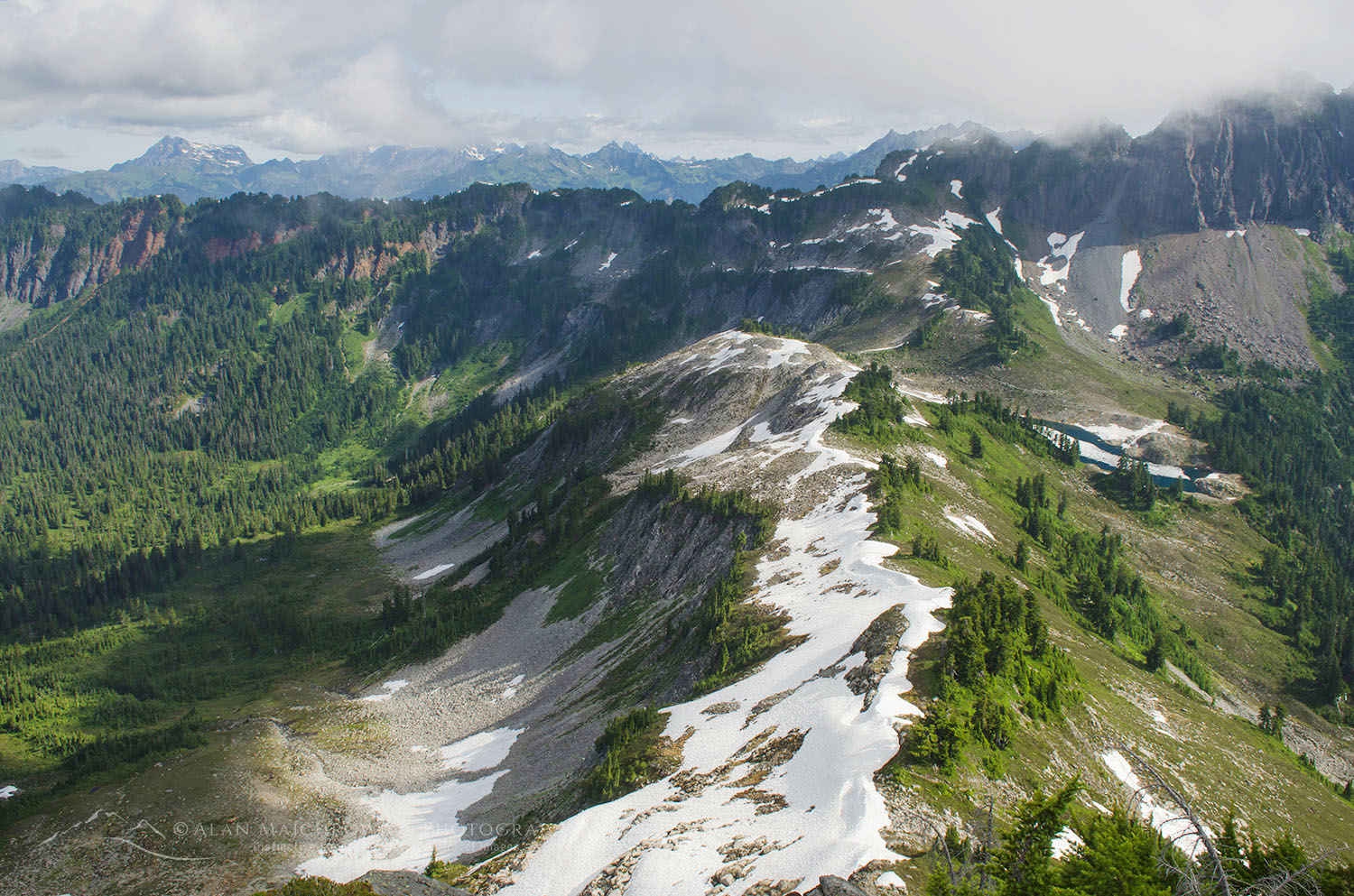 Looking north from summit of Mount Ann #58134 Purchase
Looking north from summit of Mount Ann #58134 Purchase
The journey begins by dropping about 500′ below the pass into a lovely subalpine basin at the headwaters of Swift Creek. After winding through streams, wildflowers, and rock gardens the trail enters the forest for the next mile or so. The first camping area is at a crossing of Swift creek, where the trail emerges into subalpine meadows. From here it’s about a 900′ switchback climb to the saddle above Lake Ann. Take your time here as the rocky meadows are very picturesque. This is a perfect place to see and hear pikas among the boulders.
From the saddle, the trail drops into the lake basin. Shortly before arriving at the lake a trail branching off to the left heads to close views of Curtis Glacier. From here you are at the base of Mount Shuksan and can gaze up at its immense walls and hanging glaciers.
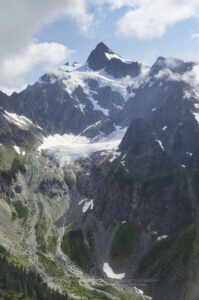 Mount Shuksan and Lower Curtis Glacier #58136 Purchase
Mount Shuksan and Lower Curtis Glacier #58136 Purchase
Hiking to Mount Ann
While most people only visit Lake Ann on a day hike or camp along its shore, there is more to explore. A worthwhile destination above and to the south of the lake is Mount Ann. From the saddle above Lake Anne climb the steep slope to gain a long ridge. Hike along this ridge to the south side of Mount Ann and pick your way through boulders and up gullies to the small summit.
From the summit of Mount Ann impressive views are in every direction. See Shuksan Creek emerging from lower Curtius Glacier. To the west is Mount Baker and the entire length of Ptarmigan Ridge. Looking south are Mount Blum, Hagan Mountain, and Bacon Peak. And far below is Baker Lake. On a clear day, you can see Glacier Peak far to the south, and maybe even Mount Rainier.
Essential Tip: Just like on Ptarmigan Ridge this trail is usually deep under snow until mid-August. Lake Ann will often have ice on it well into autumn. Crampons or micro-spikes and an ice axe will come in handy for early-season hikers.
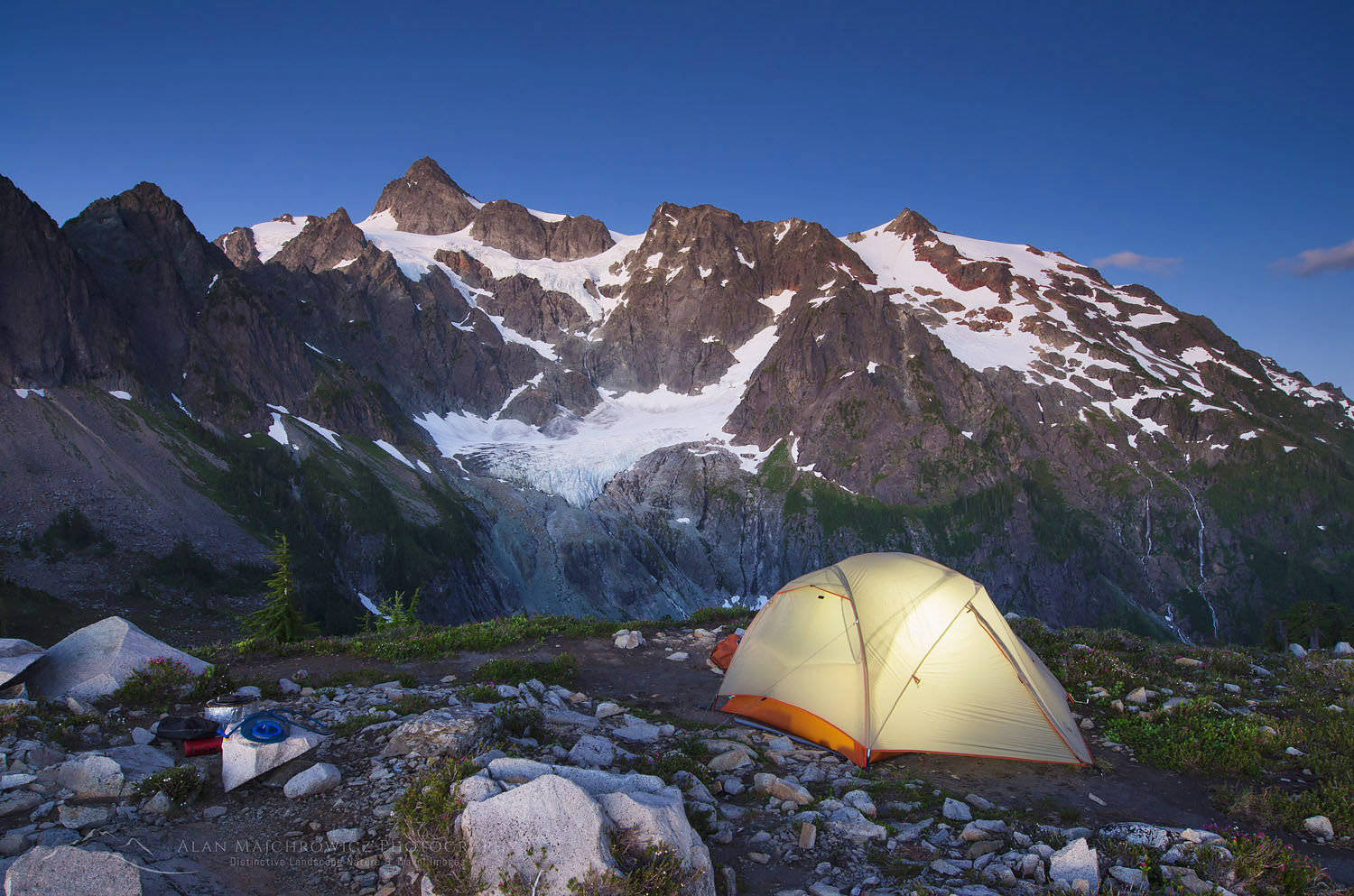 Tent on Ridge above Lake Ann #58128 Purchase
Tent on Ridge above Lake Ann #58128 Purchase
Camping at Lake Ann
An overnight trip to Lake Ann is truly something special. From camps along the lake, the imposing face of Mount Shuksan is so close you can almost touch it. But to find a spot to set up your tent will require some planning and flexibility. The few campsites at Lake Ann are among the most heavily used in the Mount Baker Wilderness.
Essential Tip: Your best bet would be to arrive on a Sunday or Monday morning, when people are heading home for the week. For a weekend stay, you’ll need to arrive at the lake very early on Friday morning. Later on Friday and Saturday, you’ll probably be out of luck.
Most of the established sites are on the east side of the lake and near its outlet. However, I feel the best sites are on the long ridge of Mount Ann above the lake. I like the view of looking down on the lake with Shuksan as a dramatic backdrop. There are several bare dirt sites on the ridge, and plenty of flat areas on snowpack to set up a tent. As a bonus, you may have the ridge to yourself compared to down at the lake.
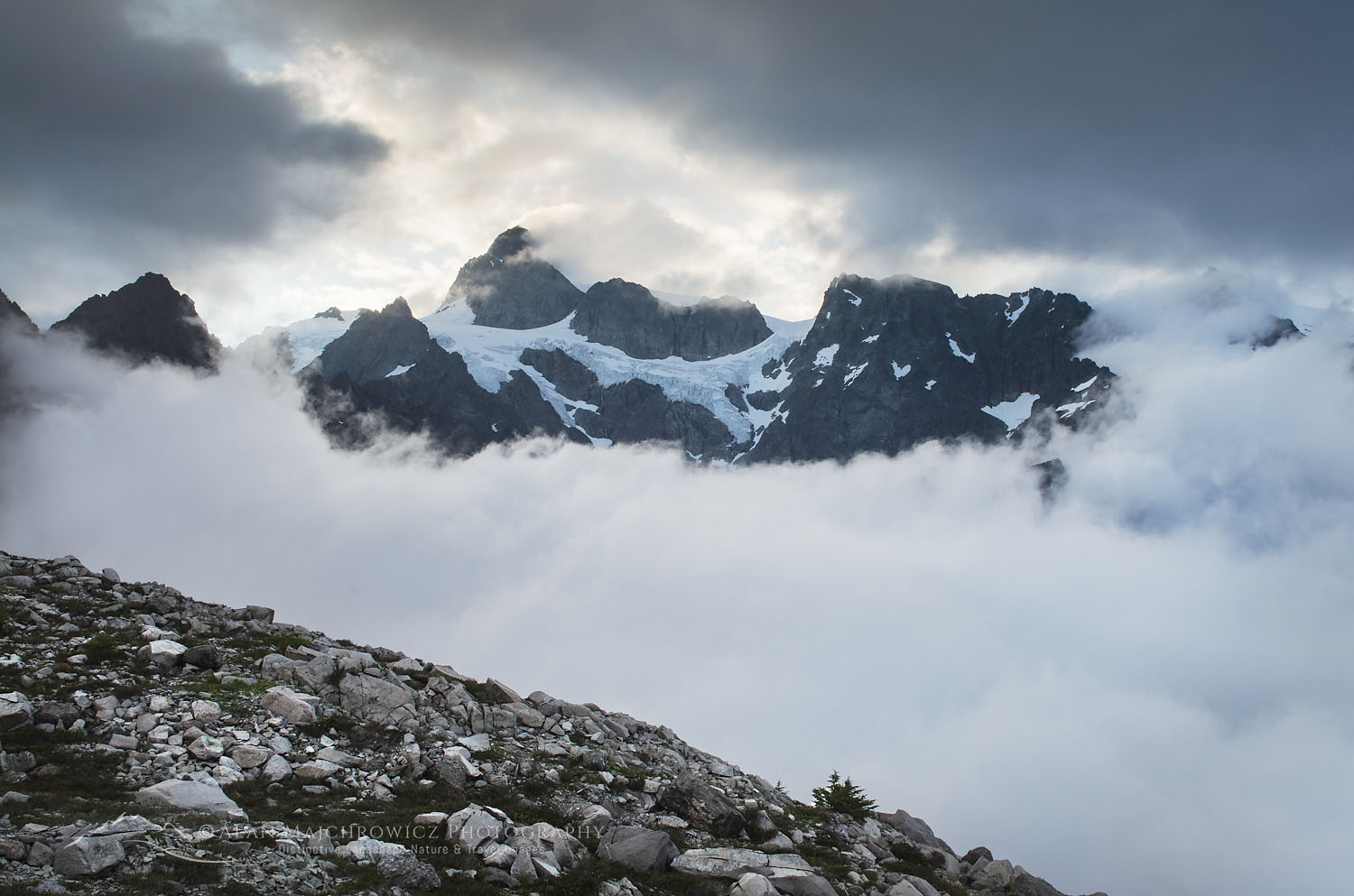 Mount Shuksan #58162 Purchase
Mount Shuksan #58162 Purchase
Photography at Lake Ann
A combination of Lake Ann and Mount Shuksan are the main elements for photography. Ice floes on the lake offer some interesting abstract patterns, and there are some small areas of wildflowers. You’ll definitely need a wide-angle lens of around 20mm to fit all of the lake and Shuksan into the frame.
From the ridge above the lake, you also have great views and compositions of Mount Baker. While most hikers prefer sunny blue sky days, clouds and weather can be a photographer’s friend. An ideal situation would be to photograph at Lake Ann, or on Ptarmigan Ridge, as a storm or weather patterns begin to clear. Clouds and fog swirling around jagged peaks give the North Cascades its trademark mysterious and primordial look.
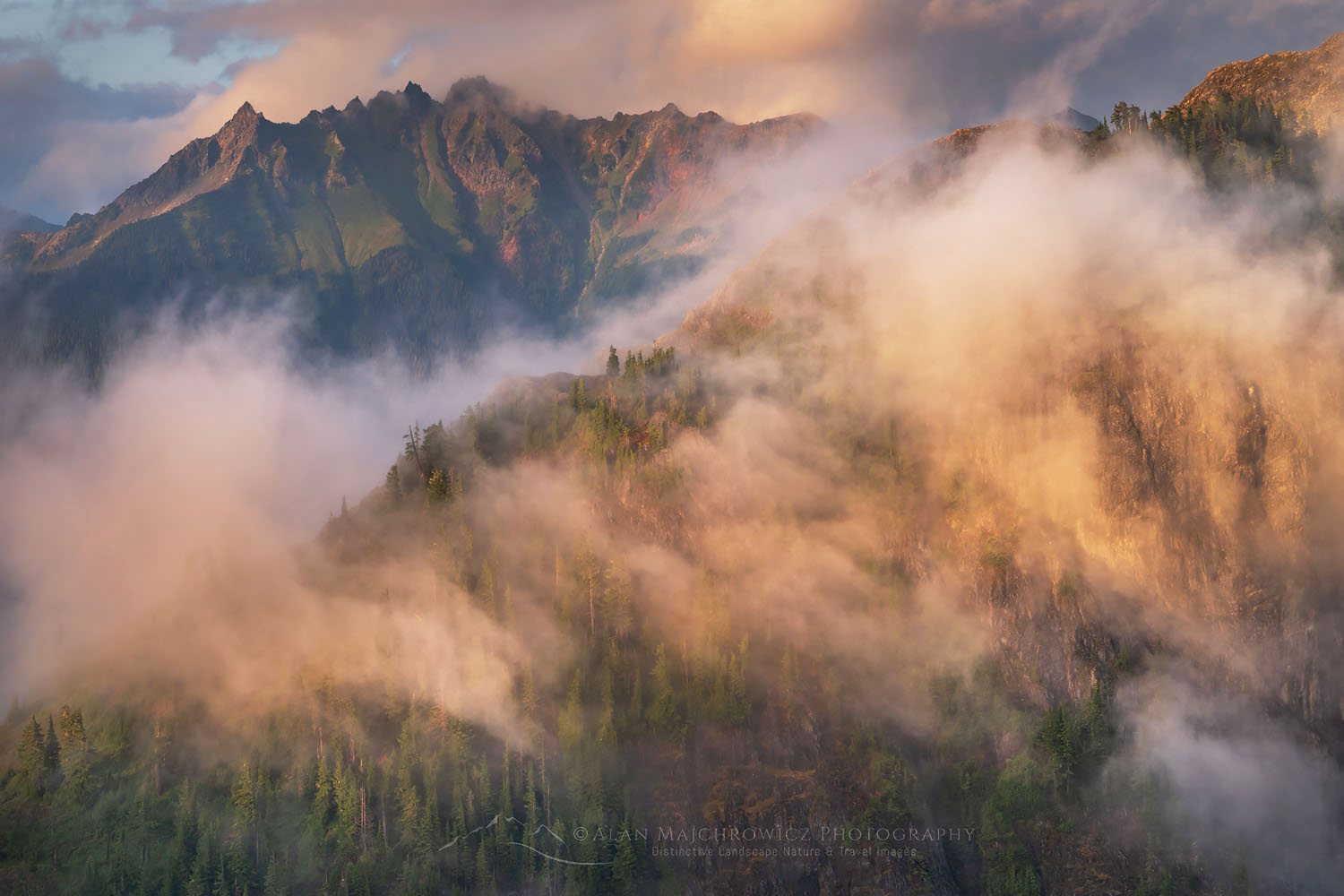 Clearing storm over North Cascades #73538b2 Purchase
Clearing storm over North Cascades #73538b2 Purchase
More Info for Lake Ann Ptarmigan Ridge
When to go: Both of these hikes and the North Cascades generally receive more snow than just about anywhere else in the lower 48 states. Most higher elevation trails are under the snowpack until early to mid-July. Of course, you can go sooner but be prepared for some route-finding. Some steeper slopes higher on the ridge may need crampons and an ice axe to negotiate safely.
Most wildflowers don’t appear until late July or early August. The exception would be avalanche lilies that begin to shoot up while still under snow. By mid-August, most of the snow will be gone and water sources may be an issue for some overnight trips. Late July through August is also the buggiest time of the year.
Both Ptarmigan Ridge and Lake Ann are very popular destinations and receive heavy use. It’s always a good idea to get an early sunrise start if possible. That way, you’ll have the trail to yourself and avoid the day’s heat and bugs.
Permits: A Northwest Forest Pass or America the Beautiful Pass is required for parking at the trailhead. However, Washington State Discover Passes are not valid. There are currently no additional permits needed for day-hiking or overnight trips.
Gear: Check my post Backpacking Photography Gear Tips for suggestions and tips on hiking, backpacking, and photography gear.
Photography tips: Check my post Backpacking Photography Tips for suggestions and tips on what camera gear to bring and for tips on making better photos during your trip.
More information about these hikes can be found on the Mount Baker-Snoqualmie National Forest website.
For more hikes in the Mount Baker Wilderness and North Cascades National Park check out these posts:
Mount Baker Wilderness Destinations
Hannegan Peak Ruth Mountain Mount Baker Wilderness
Whatcom Pass Tapto Lakes North Cascades National Park
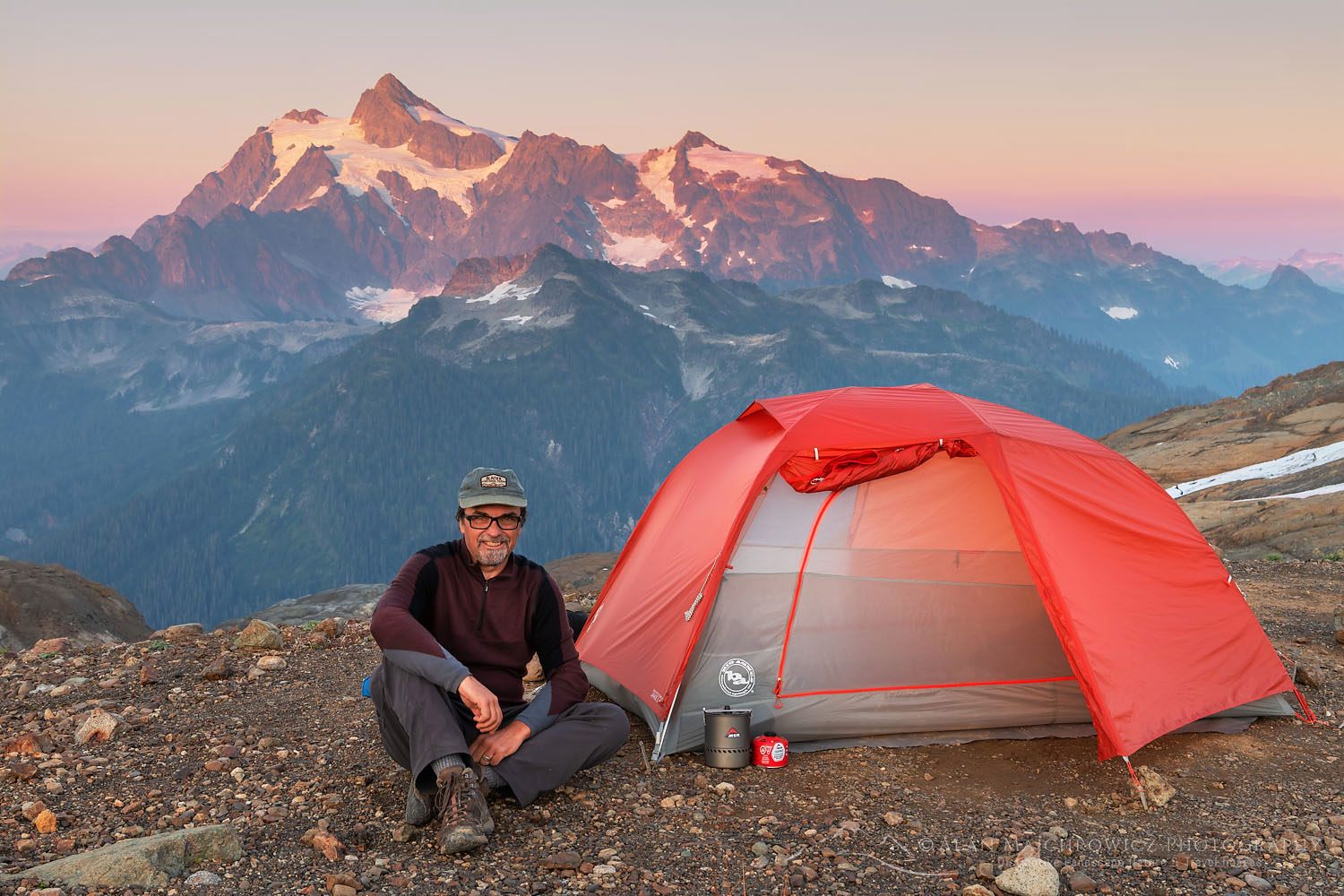 The author at camp on Ptarmigan Ridge #73641
The author at camp on Ptarmigan Ridge #73641
Leave No Trace in the Mount Baker Wilderness
Please Please Please! Don’t plan a trip to this or any other wilderness area unless you are willing to follow the guidelines of Leave No Trace (LNT). Mount Baker Wilderness and all other wilderness areas throughout the world are under incredible pressure from growing amounts of visitors. Please do your part to help preserve these precious areas for future generations!
To learn more about the principles and practicing LNT please take a few minutes to visit the Leave No Trace Center for Outdoor Ethics. Your children, grandchildren, and the Earth will thank you!
Seven Leave No Trace Principles
- Plan ahead and prepare.
- Travel and camp on durable surfaces.
- Dispose of waste properly.
- Leave what you find.
- Minimize campfire impacts (be careful with fire).
- Respect wildlife.
- Be considerate of other visitors
Learn about how to protect the places we love to photograph
Visit theNature First Website

Thanks for reading, feel free to share this post with your friends and colleagues!
Want to learn more, or have a professional photographer guide you in the field? Then take your Creative Photography to the next level with Private Instruction and Guided Photo Tours.
Photos appearing in Lake Ann Ptarmigan Ridge Mount Baker Wilderness are available for Commercial Licensing and Fine Art Prints. Click on any image to purchase, or contact me for more info!
Lake Ann Ptarmigan Ridge


